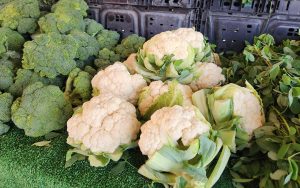
Brian Griffith, right, sells oranges to patrons at the farmers market at Central Avenue and 43rd Street in Los Angeles. Griffith accepts Market Match funds, which help SNAP recipients extend their food budget. (Photo by Taylor Ens/Cronkite News)
LOS ANGELES – Every Thursday, people come to the Central Avenue farmers market at E. 43rd Street in downtown Los Angeles to find fresh produce from local growers – bright red tomatoes, vibrant broccoli and crisp cauliflower. The prices might discourage some low-income customers from shopping there, but this market is different.
At this farmers market, run by Sustainable Economic Enterprises of Los Angeles (SEE-LA), some low-income people can afford to buy fresh fruits and vegetables that could help make their homes more food-secure, thanks to a special program called Market Match.
Food security is a term used to evaluate if people have reliable access to a sufficient quantity of affordable, nutritious food. Recent data shows that low-income households in Los Angeles County don’t.
As of July 2022, nearly one out of four L.A. County households were food-insecure, according to a University of Southern California Dornsife report.
The Los Angeles County Department of Public Health (LACDPH) is working to combat that number. One way it is doing that is with the Market Match program, which gives people who are already receiving SNAP funds (Supplemental Nutrition Assistance Program) extra money to spend at farmers markets.

Crisp, vibrant vegetables from Chavez Farms. (Photo by Taylor Ens/Cronkite News)
“They go to a farmers market and swipe their card for $10 in SNAP and then they get another $10, and now they have $20 to spend on fresh fruits and vegetables,” said Dipa Shah, director of the Nutrition and Physical Activity Program for the LACDPH.
“Market Match incentivizes the consumption, or the purchase at least, of healthier foods. And there’s a lot of data that shows that these nutrition incentive programs really work,” Shah said.
In 2022, consumers spent over $19.5 million in Market Match and CalFresh funds combined at approximately 270 participating locations, according to the Market Match Statewide Impact Report.
Among three-person households with incomes under about $75,000 a year, the prevalence of obesity (36.9%), diabetes (17%), hypertension (30.4%), high cholesterol (30.4%), and depression (23.9%) was higher among adults living in food-insecure households, than among adults living in food-secure households (29.6%, 11.8%, 24.2%, 25.6% and 8.4%, respectively), according to the LACDPH Food Insecurity report in 2018.
Other contributing factors to food insecurity are the number of food deserts, areas where it is difficult to buy affordable, nutritious fresh food, and food swamps, areas where there is a high number of fast-food restaurants and other cheaper unhealthy alternatives.
Cuauhtemoc Aguilar is a vendor at Chavez Farms at the farmers market at Central Avenue and E. 43rd Street, which is sandwiched between Jack in the Box and KFC restaurants at each end of the sidewalk. Aguilar says that the Market Match program helps many in this LA community get the nutritious produce they need despite the price.
Aguilar says that the quality of the produce at the market is worth the price markup compared to grocery chains. “So when they come, everyone says it’s very fresh, it’s not too cheap but the quality is very good,” Aguilar said.
“A lot of low-income families struggle to put food on the table. So when we develop programs, we take a look and take that into account. So we’re not just trying to tell people, ‘Hey eat healthy … eat all these fruits and vegetables and good luck trying to afford all of these things,’” said Shah.

Bright red fresh tomatoes can be purchased with Market Match funds at the farmers market at Central Avenue and E. 43rd Street in Los Angeles. (Photo by Taylor Ens/Cronkite News)
Brian Griffith, of Griffith Family Farms, has been coming to this specific market for 10 years and was skeptical of the program at first, but sees that it helps people and strengthens the community.
“You know there’s too many freebies and giveaways, it feels overdone…but from what I’ve seen here at the market, it’s the best damn investment you can make in a human being,” Griffith said.
As people walked through the farmers market, Griffith and other vendors recognized customers, called them by name and interacted with kids, giving them free orange slices. He and Aguilar say that this environment helps create a routine that is crucial to cementing the culture of healthy eating in LA.
“This woman is buying eggs, she’s not buying a Big Mac,” Griffith said after politely pausing our interview to help a customer. “I’d rather be here where they take food from here and they’re going to take that home, they’re going to cook it and they’re going to do family things.”
Several vendors said the Market Match program benefits them as well as the low-income families by helping establish a sense of community.
Griffith puts it bluntly, “They want a better life for their family. Plain and simple.”

